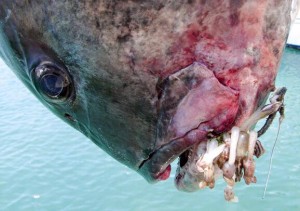From Kona Fishing Chronicles January 2012.
Diver Bruce Ayau speared an 87-pound ulua off Kona’s OTEC Point and swam to shore towing an oddity. A circle hook was jammed in the ulua’s jaw hinge and appears to have been there for so long that the jawbone had grown tightly around it. The hook had even become infested with gooseneck barnacles. When fisherman Uha Farias tried to remove the hook for closer inspection, he could not work it free no matter how he tried. Finally, he gave up and discarded it along with the carcass.

Don’t expect the hook to rust away quickly. Because it is constantly immersed in salt water without being exposed to oxygen, the metal will stay strong for a very long time. Try it for yourself. Submerge a hook in a jar of saltwater, set it aside, and watch it. You will still be looking a
What do incidents like this add to the controversy over the use of circle hooks versus J-hooks as conservation measures? If this had been a J-hook, the ulua would have almost certainly shed it very soon after breaking free. But the fish might very well have swallowed a J-hook and which would have killed it during the fight.
To me, the hook looked as though it had broken free of a slidebait rig. The area is popular with shore fishermen but ulua sometimes travel long distances, so this fish could have been hooked and broken free from any of a hundred ulua fishing spots ringing the Big Island. From the condition of the hook and the jaw of the fish, and the growth of the barnacles, the ulua would have had plenty of time to swim from anywhere in the Islands. Except for festering around the hook, the ulua seemed to be in good condition and was thriving despite what seemed to be only an inconvenience.
Shore fishermen and bottom fishermen choose circle hooks partly because they do anchor firmly in the jaw hinge without the need to strike the fish to set the hook. But they also choose circle hooks because the rolled-in point reduces the chance of snagging on the bottom.
But the bigger issue is the growing use of circle hooks in billfish conservation, especially for live-bait fishermen. By contrast, J-hooks are the standard for rigging trolling lures. A billfish rarely gets the opportunity to swallow the hook on a lure, and a good crew can usually release most J-hooked fish after freeing the hook. Even if the hook is cut free, the fish will usually shed it.
Circle hooks are now becoming the standard for use with bait, and in some areas and circumstances are even the requirement. Even if a fish swallows the bait, the hook usually ends up in the jaw hinge. A crew has a much harder time working the circle hook free and is more likely to cut the leader and leave the hook for the fish to deal with on its own.
As Bruce’s 87-pound ulua shows, for a fish, dealing with the circle hook on its own means learning to live with it.
Don’t expect the hook to rust away quickly. Because it is constantly immersed in salt water without being exposed to oxygen, the metal will stay strong for a very long time. Try it for yourself. Submerge a hook in a jar of saltwater, set it aside, and watch it. You will still be looking at it a year from now. The Charter Desk in Honokohau Harbor
Jim Rizzuto
From Fernando Nieves: YOU ARE SO RIGHT JIM. A LOT HAVE TO DO WITH ”NO AWARENESS/EDUCATION.” I SEE GUYS CUTTING 75ft OF LINE BECA– USE THEY GOT HANG AND NOT DO ANY EFFORT TO RETRIEVE THAT LINE, HOOK AND SINKER. AND THE MAJORITY NOT REALIZE THEY JUST LOST A CATCH…